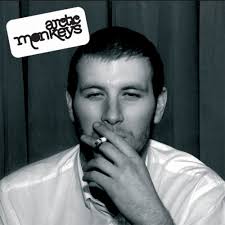JT: Album Cover Analysis
Arctic Monkeys – Whatever People Say I Am, That’s What I’m
Not
- This is the album cover for the indie rock band, Arctic
Monkeys debut album Whatever People Say I Am, That’s What I’m Not (Jan, 2006).
The cover artwork of the album is a photo of Chris Mcclure - a friend of the band taken in a bar called
Korova in Liverpool.
- When deconstructing the album cover through semiotics there
are many different codes we can use created by Barthes narrative theory (1957).
- Firstly enigma codes are used in the artwork as there is
mystery in the photo, giving no clear meaning of the photo or suggestion of
what they want to show or how they want the audience to feel when they look at
the artwork. For example some may perceive it as promoting smoking and making
it acceptable, which it did in fact cause controversy with the head of Scotland’s
NHS, reinforcing the idea that smoking is okay. However some may also perceive it
in the complete opposite way in that the cover suggests smoking is clearly not
doing him any good. This enigma code therefore also overlaps with Barthes;
cultural code weather smoking is generally a well-accepted part of current
society or whether it is just a rock n roll image as they do not care for their
health at the time and looks ‘cool’.
- Semantic codes refer to parts of text which have additional
meaning or more is suggested behind the artwork. For example semantic codes are
used in this album cover as I believe the photo refers to the lifestyle the
band live or once lived. The man looks very rugged and possibly under the
influence, with a cigarette in hand, representing a very laid back, cool,
working class, Rock 'N' Roll lifestyle. This is also supported by the music on
the album as a lot of their songs are about their experiences when they were
younger.
- Through the use of Barthes symbolic code I think the album
artwork suggests an almost thuggish feel, of young people causing trouble. The
picture almost represents everything the young man cares about at that time in his
life, going out, causing trouble, being under the influence and not caring for appearances.
This is what would attract audiences that may consider them to live the same
lifestyle of think they do.
- We can also deconstruct album artwork by using Richard Dyer’s,
star theory (1979). Dyer said that the feature of stars is that a star is an
image, not a real person that is marketed to their target audience. In the album
cover the photo follows both paradoxes of Dyer’s theory. Firstly the cover is simultaneously ordinary
and extraordinary for the consumer. It is
ordinary as it is first person relatable to everyday situations as the man on
the cover looks like your everyday guy potentially. This is shown by him smoking and the fact he
is not a band member and not well known there doesn’t appear to be anything
special about him at face value. Moreover he can also be seen as extraordinary
as he is also mysterious and the fact the audience are so unfamiliar with the
man adds to this. He looks like he should be on the cover and represents the
rock n roll lifestyle.
- Furthermore the band is also present in the fact that their
friend is representing what they write music about and what they represent as
people through their talent. However the audience are also obviously distanced
from the band as its not them shown on the front cover. Showing there is more
parts to them than just the music. The consumers are attracted to take this
approach in life or at a stage in their lives of not caring and being better
than the law, potentially encouraging outlandish behaviour.

Very good work Jacques, please can you change the title to JT: Album Cover Analysis
ReplyDelete